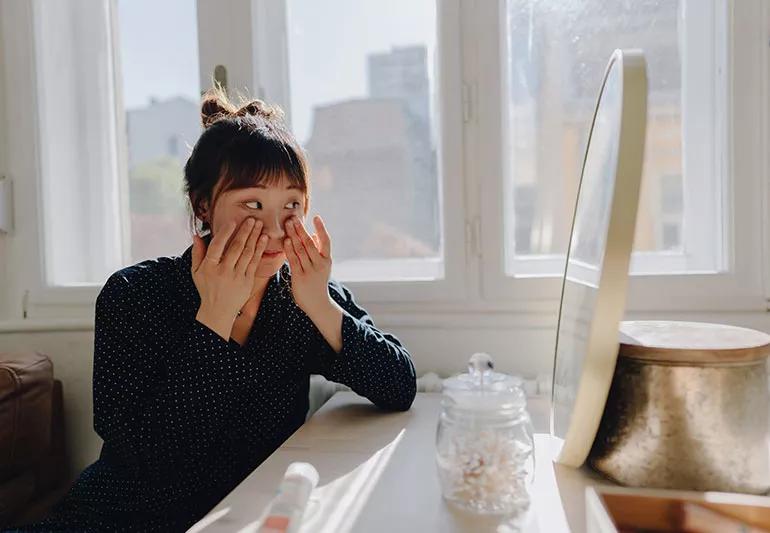Look for ingredients like retinol and peptides to help with wrinkles, dark circles and puffiness

Wrinkles, puffiness, dark circles (oh my!). Are your eyes feeling more Wicked Witch than Dorothy?
Advertisement
Cleveland Clinic is a non-profit academic medical center. Advertising on our site helps support our mission. We do not endorse non-Cleveland Clinic products or services. Policy
It might be time to start using an eye cream as part of your skin care routine.
As we age, the skin around our eyes starts to form wrinkles, commonly called crow’s feet. And aging can also cause puffiness and dark circles (as can a late night out or a meal high in salt).
Whether you’re in your 20s and thinking about prevention or in your 60s and are concerned about the signs of aging, an eye cream can be beneficial.
So, what should you look for in an eye cream? Well, not all eye creams are created equally. You really have to look at the ingredient list and choose wisely.
Dermatologist Shilpi Khetarpal, MD, shares the best eye cream ingredients to target your top concerns.
With so many eye cream options available at the store and online, how do you choose? Dr. Khetarpal suggests looking for a formula that has ingredients known to target your main concerns. Here are some of the top ingredients.
Antioxidants protect against cell damage and keep your eyes twinkling. Look for ingredients such as vitamin C, vitamin E and ferulic acid that help prevent environmental damage. Antioxidants can help decrease swelling and puffiness. Vitamin C has gained popularity as a skin brightener, too.
Advertisement
Retinol is the darling of dermatologists and beauty buffs alike, and for good reason: It works. Retinol, a form of vitamin A, stimulates collagen to reduce and prevent lines and wrinkles. It’s the go-to ingredient to look for in anti-aging eye creams.
Crepe paper: Festive when it’s hanging for a party, not from your eyes. For drooping, crepey skin around your eyes, look to peptides, which increase collagen and elastin to firm up sagging skin.
The skin around your eyes is the thinnest on your body, which means it gets dry and irritated easily. Soothe thirsty skin with moisturizing ingredients like hyaluronic acid and ceramides. Bonus: Hydrated skin is plumper, so wrinkles are less visible.
Even the best eye creams can’t fix a bad night’s sleep. But if undereye discoloration persists even when you’re rested, genetics could be to blame. Try niacinamide and kojic acid. They brighten skin by reducing activity in pigment-producing cells.
Whether you’re young or not-so-young, worried about wrinkles or calm and carefree — sunscreen is a must. You can use the same SPF you put on the rest of your face or grab a product designed for the eye area. But to protect against skin cancer and sun damage, don’t skip this step.
You typically want to apply products from lightest to heaviest. Apply your eye cream after you cleanse your skin and apply sunscreen. Then use your moisturizer. The idea is that by applying your eye cream before your moisturizer, the ingredients can easily penetrate your skin.
And when you apply your eye cream, use a gentle touch. All you typically need is a small amount of the eye cream. You want to use a finger (your ring finger works well) and gently pat the product around your eyes, avoiding pulling or tugging on your skin.
It depends on you and what your concerns are. There isn’t a one-product-fits-all answer.
Eye creams are available at every price point, ranging from affordable to, “Is this a tiny jar of lotion or liquid gold?” Expensive doesn’t always mean more effective. Look for a cream that has the right stuff for your eye goals — and the right price tag for your wallet.
If you want to feel pampered, there are plenty of fancy eye products that look, feel and smell like a dream. But creams with a strong scent can irritate and dry out delicate eye skin. And just because something looks indulgent doesn’t mean it works.
Overall, it’s best to do your homework, read reviews and talk to a dermatologist about what they might suggest.
Advertisement
Learn more about our editorial process.
Advertisement

Moisturizing, running a humidifier and adjusting your showers may help keep itchiness and irritation at bay

Glycolic acid benefits skin tone, texture and pigmentation by exfoliating dead skin

Some gentle soap and warm water go a long way when you’re washing these cosmetic tools regularly

New formulas are less drying and contain water-based and skin-loving ingredients

At a minimum, in the morning, apply a cleanser, followed by a moisturizer and sunscreen, in that order

The convenient option is good for touch-ups, but it shouldn’t replace your traditional sunscreen

Olive oil works as a skin moisturizer, but it’s not right for everyone

Sunscreen, moisturizer and a topical antioxidant every day are a good start to a good skin care routine

The best parenting style balances enforcing rules and showing plenty of love

Tips include cutting back on sugar, focusing on exercise and managing stress

It can be harder to let go when you’ve invested time, energy and emotions — but it might be the healthier choice long term